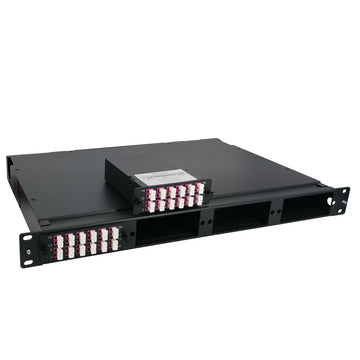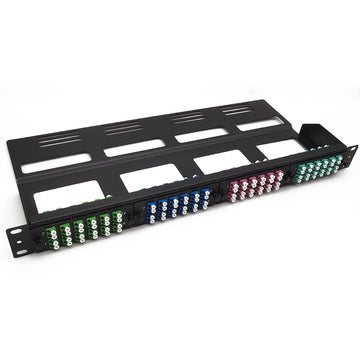Fiber Optic Cable vs Wireless: Which One Would You Choose
With the swift development of science and technology, the majority of people have access to the Internet. Our home and enterprise networks rely on either wired technology or wireless technology.
Wireless communication technology is also regarded as a modern alternative to traditional wired networking. Since Internet Service Providers (ISPs) use fiber optic cable to span very long distances, the service consumers are looking to choose is the one to cover the “last mile” stretch to their location. It might at first seem logical to continue with fiber optics, but what benefits does wireless offer?
When both sides: fiber optic cable vs wireless are the opposites in a competition, which one will win the favor? However, today with the development of networking, is copper cabling really cheaper than fiber optic cabling?
What Is Fiber?
Fiber optics is a technology that allows information to be sent over great distances as light pulses via strands of glass or plastic fiber. Optical fibers are the size of a human hair and, when grouped together in a fiber-optic cable, can carry more data over greater distances and at a quicker rate than other mediums.
Fiber is a method of transmitting information from one place to another by sending pulses of light through an optical fiber. It is delivered through thin glass pipes known as fiber optic cable with the usage of light waves. This technology is generally considered as the successor to DSL broadband which is delivered over copper telephone network. Fiber-optic internet, phone, and television services are available to homes and businesses using this technology.

What Is Wireless?
Wireless networks are computer networks that do not use cables to connect them. Wireless broadband (or 4G, fourth-generation wireless) is a generic term that refers to a number of different ways for transmitting an Internet connection using radio waves.
Sometimes wireless is also referred to WiFi network or WLAN. This network is getting popular nowadays with the feature of easy setup and no cabling involvement. They let devices stay connected to the network while traveling inside the coverage area of the network that you can connect computers anywhere in your home without the need for wires.
Home Wiring Fiber Optic?
Fiber-optic is delivered via a cable, either from underground or an aerial power pole, that goes right into your house. This is called Fiber to the Home, which is just what you want if you can get it. Your internet service provider will bring it right to your door. Of course, it’s what’s inside the cable that counts. Fiber-optic technology sends the data as pulses of light through hair-thin strands of fiberglass. Information travels practically at the speed of light, giving you more reliability and less latency or buffering.
Single family homes, apartments, condominiums and other multi-dwelling units are increasingly wired with fiber optic cable to future-proof installations and create more reliable, higher-bandwidth and faster speed network and video infrastructures.
Fiber Optic Cable vs Wireless: Which One Is Better?
If you think that wireless network transmits data at the same rate as fiber optic cable does then you are wrong. We are going to compare fiber optic cable vs wireless from below 3 aspects:
Speed:
Theoretically, the wireless network can transmit data at the same speed as fiber optical cable does then you are wrong. Practically, fiber optical cable can achieve higher maximum speed. For example, wireless network becomes quite slow during peak hours because all users of wireless network start sharing the same network and its bandwidth. Due to the congestion of the network, wireless connection becomes slower whereas fiber optic network does not get affected in such situation. The connection speed remains good even during peak hours. A wired Ethernet connection can notionally offer up to 10Gb/s if you have a Cat6 Ethernet cable. The exact maximum speed of your Ethernet cable depends on the type of Ethernet cable you are using.
Convenience of Installation:
Today people need more freedom and comfort to enjoy life. Similarly when it comes to getting an internet connection, they all want a modem or device which they can carry here and there without any trouble. To install fiber network can be time consuming and quite complicated. Depending on the business environment and other variables, the process of installation of fiber network usually takes months. On the other hand, installing Microwave Fixed Wireless Internet only takes days and requires fewer resources. When internet has become an essential part in today’s life, no one wants to disconnect themselves from the web world. While you are moving or travelling, wireless device is quite handy in accessing the web world. Similarly when you check-in in many hotels, coffee shops and restaurants, you don’t need to ask for an internet wire, you just need to get connected to a wireless network of these places to enjoy web access.
Distance:
The signal with a wireless connection gets degrade with distance. Furthermore, the signal strength of wireless can be weakened over long distance. Fiber optic wire can convey a clear signal much farther. Take single mode fiber of wired network as an example, it is applied for wide-range data applications and commonly used in carrier networks, PONs, and MANs. In general, wired network offers quicker speed and longer distance transmission without interference and is more reliable than WIFI as well.
Conclusion
Each coin has two sides. For fiber optic cable vs wireless, the network connection is no exception. Wired connection will provide more reliability and have less potential for interference. While wireless connection will offer greater flexibility and the ability to easily addition of devices to your network. A combination of the two systems — fiber optic and wireless — may be the best solution. Many systems and networks use both fiber optic and wireless signals, so they may complement each other. It all depends on what you would like to do and how you want to use your connection.
If you have any demands for products to set up a wired Internet, LightOptics would supply a variety of relevant fiber optic cables and other applications.













